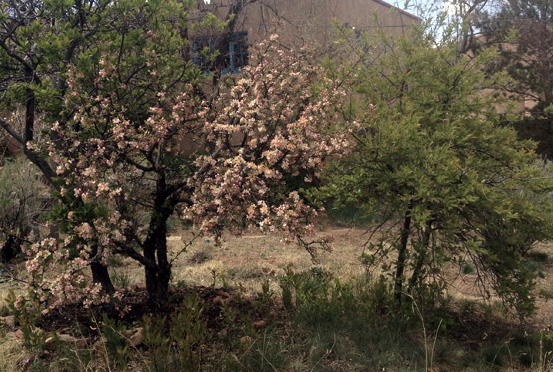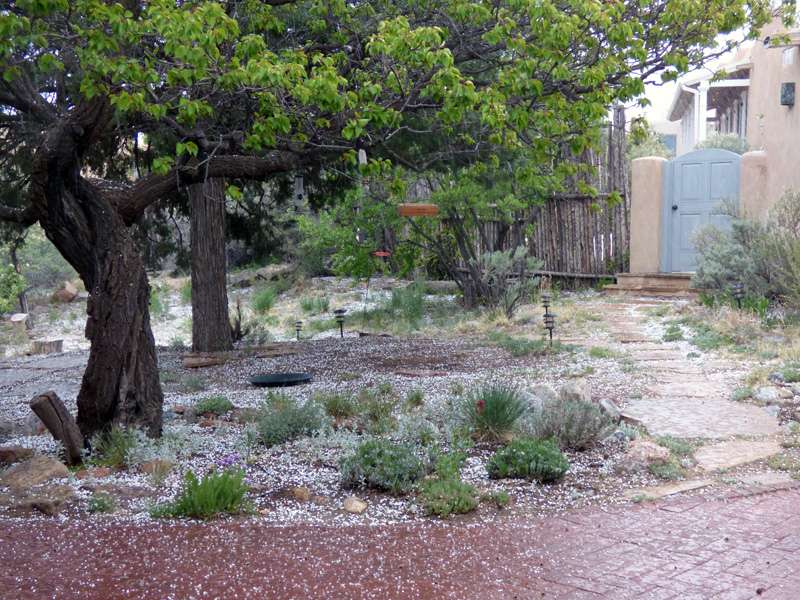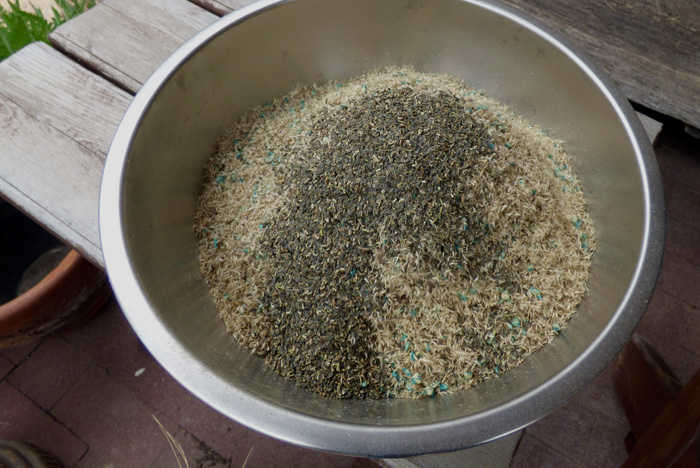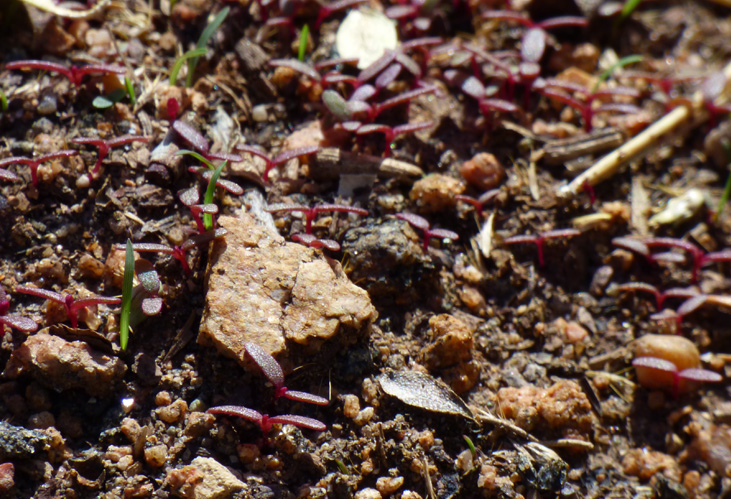“In springtime you’ll need to do some pruning and pull the weeds,” she wrote.
No problem, I thought. It was late winter, and the landowner and I were emailing about my new part-time job as gardener of our third-of-an-acre yard. She had done the gardening herself when they lived here some years ago, so of course I could too. No problem.
“And then we’d like some native grasses and wildflowers sowed in the bare patches.”
My eyes lit up. Gardening with native plants—my kind of yard! I couldn’t wait to start.
First on the list in April was pruning the chamisa (or rabbitbrush). Each of the dozens of tall shrubs needed attention, and I took it slowly, my aching arms reluctant to remember what physical labor felt like. But after some weeks my shoulders were toned and the rows of chamisa stood neatly.
 As the sun rose each morning, I would wander into the yard with a cup of tea and bend to the ground, hunting cheatgrass. I pulled cheatgrass by the stem, I pulled it by the handful. For two weeks straight I stuffed our 96-gallon trash can to the brim with cheatgrass stems alone. In shady corners it grew tall and lush, but on dry sunny slopes it could set seed from a stem only an inch or so high. My respect for cheatgrass grew, along with calluses on my knees.
As the sun rose each morning, I would wander into the yard with a cup of tea and bend to the ground, hunting cheatgrass. I pulled cheatgrass by the stem, I pulled it by the handful. For two weeks straight I stuffed our 96-gallon trash can to the brim with cheatgrass stems alone. In shady corners it grew tall and lush, but on dry sunny slopes it could set seed from a stem only an inch or so high. My respect for cheatgrass grew, along with calluses on my knees.
 Between pruning and weeding, I tested the drip irrigation system ringing the property, digging up every line and replacing clogged parts. Did I mention an aching back? I’m ten years older than when I last crawled around a yard!
Between pruning and weeding, I tested the drip irrigation system ringing the property, digging up every line and replacing clogged parts. Did I mention an aching back? I’m ten years older than when I last crawled around a yard!
Through blustery days and warm scented afternoons, I pruned and weeded and dug. In April, bundled in long johns and layers, I was surprised to feel toasty and content even in strong winds and 48 degrees, as long as the sun shone. I let the peace of the dirt seep in. I followed the currents of birds and thrilled to the humming of bees hard at work in flowering trees. Gardening was good, I discovered, for the inner transformation I’ve been going through; living outdoors among the swirling nature helped me integrate.
 When I wasn’t gardening, I stalked birds in the yard with my new zoom lens. Bullock’s orioles are wary, and this male was so far away that he still came out fuzzy. New quest: a good oriole photo.
When I wasn’t gardening, I stalked birds in the yard with my new zoom lens. Bullock’s orioles are wary, and this male was so far away that he still came out fuzzy. New quest: a good oriole photo.
 This male black-headed grosbeak was more accommodating because I was hidden behind glass.
This male black-headed grosbeak was more accommodating because I was hidden behind glass.
 By early May the yard was imperceptibly neater (imperceptible—after all those hours!) but still yellow-brown. After four years of drought, including a dry winter and spring, the land could not yet turn green.
By early May the yard was imperceptibly neater (imperceptible—after all those hours!) but still yellow-brown. After four years of drought, including a dry winter and spring, the land could not yet turn green.
 I couldn’t wait to get busy sowing grasses and wildflowers. But at my favorite native plants store they told me that unless the ground had warmed up to 60 degrees the seeds would just sit there and not germinate.
I couldn’t wait to get busy sowing grasses and wildflowers. But at my favorite native plants store they told me that unless the ground had warmed up to 60 degrees the seeds would just sit there and not germinate.
In mid-May we were enjoying balmy days in the high 70s, and I was chomping at the bit. But spring in Santa Fe is fickle, and at the end of one warm week we got a day of hail-sleet-snow and at the end of the next, on May 15, a killing frost.
 Time to wait some more. I took the opportunity to purge two weedy plants from the yard: mustard (it’s invasive) . . .
Time to wait some more. I took the opportunity to purge two weedy plants from the yard: mustard (it’s invasive) . . .
 and stickseed (its prickly burrs hurt bare toes and demolish socks).
and stickseed (its prickly burrs hurt bare toes and demolish socks).
 At some point it dawned on me that I was doing restoration work. I’d helped to restore riparian corridors in Oakland and wildflower meadows in Boulder. Now I was managing my own high prairie restoration project in the Transition Zone of Santa Fe!
At some point it dawned on me that I was doing restoration work. I’d helped to restore riparian corridors in Oakland and wildflower meadows in Boulder. Now I was managing my own high prairie restoration project in the Transition Zone of Santa Fe!
Jubilation was tempered by the the other realization that dawned about the same time: 12,000 square feet is a lot of space. This was a bigger job—and responsibility—than I’d expected. Anxious questions began to arise: How would I know when to plant? How much to plant? Was there any leeway for errors?
Finally the ground warmed up once more. I set hoses and sprinklers in place (no simple job to cover all from two faucets!). Was it time?
I followed the weather reports. Rain was predicted for the end of the week.
By Thursday afternoon all was in place. I checked the sky. The clouds were growing black. It was time to plant.
 I opened bags of seeds and stirred them into a bowl: a mix of native blue grama and buffalograss plus wildflowers such as yellow coneflower, Mexican hat, blanketflower, and blue flax.
I opened bags of seeds and stirred them into a bowl: a mix of native blue grama and buffalograss plus wildflowers such as yellow coneflower, Mexican hat, blanketflower, and blue flax.
 I sprinkled seeds onto the ground and lightly raked them in, not because these native seeds needed to be covered—they didn’t—but to hide them with the thinnest layer of dirt so that, as they told me at the nursery, “the birds don’t see dinner and the ants don’t carry them off.”
I sprinkled seeds onto the ground and lightly raked them in, not because these native seeds needed to be covered—they didn’t—but to hide them with the thinnest layer of dirt so that, as they told me at the nursery, “the birds don’t see dinner and the ants don’t carry them off.”
Halfway through the planting the wind kicked up and threatened to carry off my precious cargo. I clutched the bowl to my chest, protecting its light-as-air contents, then enlisted Tim to follow right behind me with the rake.
The gusty winds foretold rain, but here in the desert I’ve already learned not to believe the wind. It may blow strong, and rain may fall from the clouds, parading across the sky, only to evaporate thousands of feet above the ground, never dampening the earth. So despite gusty winds, I set the sprinklers and gave the seeds their first bath.
At 3:00 the next morning I woke to lightning and thunder, then a sound I hadn’t yet heard in Santa Fe—rain pounding on a roof. I crept out of bed to a dark window.
Torrents of water! This drought-stricken land was finally getting relief.
The next morning dawned bright and sparkly fresh—for a few hours. What a gift, to see wet dirt where yesterday it had been bone dry! More heavy showers fell that afternoon, flooding city streets, then more rain on Saturday and Sunday as well—a dark and wet Memorial Day weekend.
The locals were delighted. Something in us relaxed as we felt the earth around us stretch and plump, freshening with new life. People greeted one another laughing. “Isn’t this rain wonderful?”
In between showers I wandered the yard, checking seeds. The rain had uncovered many but not washed them away. After two days of rain they began to stretch, their old jackets suddenly too small.
 Each day for a week I checked the ground, waiting and watering. Finally I glimpsed the first evidence—thousands of minuscule shoots. I didn’t expect grass to be red!
Each day for a week I checked the ground, waiting and watering. Finally I glimpsed the first evidence—thousands of minuscule shoots. I didn’t expect grass to be red!

 It’s been a week and a half since the seeds landed in dirt and were watered by glorious rains. Their tiny shoots are now weaving a gossamer green film across bare earth.
It’s been a week and a half since the seeds landed in dirt and were watered by glorious rains. Their tiny shoots are now weaving a gossamer green film across bare earth.

